You have finalized your quantity takeoff for a new school build. The design is complex, timelines are tight, and you want everything right. Then during construction a concrete shortage appears. After some digging the cause is clear. The slab thickness was miscalculated in your quantity takeoff.
One small miss snowballs into delays, extra costs, and a tough client call. This is why avoiding quantity takeoff mistakes matters. Accurate quantity takeoffs keep bids realistic and schedules honest. Even a minor miss in a slab spec or a plan revision can trigger budget overruns and late nights for the team.
Whether you are a quantity surveyor, estimator, contractor, or project manager, knowing the most common quantity takeoff mistakes before you start can save stress later. Below are six patterns we see again and again, plus simple ways to fix them fast.
6 Quantity Takeoff Mistakes You Should Avoid

Mistake 1: Rushed measurements
Incorrect dimensions or area counts change material quantities and costs. Misreading floor dimensions during takeoff leads to shortages and schedule slips. Manual quantity takeoffs make this harder. Flipping through hundreds of sheets under tight deadlines invites takeoff errors. Tools like Beam AI automate the heavy lifting and can save up to 90 percent of your time. That time goes back to vendor coordination, bid refinement, and winning more work. Watch for this early because it is one of the classic quantity takeoff mistakes.
Want to know how Beam AI can automate your takeoffs? Talk to us!
Mistake 2: Skipping project specifications
Specs hide details that change quantities and pricing. If you price a plumbing system with standard PVC but the spec calls for copper, you pay for rework and you lose trust. Make spec reviews a non negotiable step. Use checklists, flag unusual requirements, and keep the latest documents visible to the team so you avoid estimating issues. This habit reduces takeoff errors at bid time.
Mistake 3: Not updating takeoffs
Creating the first pass is only step one. Last minute spec changes, a client request, design tweaks, or site surprises will follow. If your takeoff does not reflect addenda, your project drifts off course. Upload new sheets and compare changes so you catch takeoff errors early. Automated takeoff software like Beam AI picks up new quantities when you upload addenda. With everything in one place, vendors see the latest version and you avoid estimating issues.
Mistake 4: Ignoring site conditions
Plans can look perfect. The field tells the truth. You estimate a small retail building and assume a flat site. The crew arrives on a slope. Now you need extra fill, layout adjustments, and maybe retaining walls. Costs rise and schedules move. Review soil reports, terrain, and drainage so your takeoff reflects the real site and you avoid estimating issues.
Mistake 5: Thin collaboration
Construction moves fast and updates get lost. Your estimator finishes a multi unit residential takeoff. Days later the structural engineer shares a beam sizing change that shifts the framing layout. The addendum lands in email and does not reach everyone. The bid goes out on old assumptions. Later procurement catches it and you scramble. Hold quick check ins, keep shared folders for drawings, and use takeoff software with sharing to cut takeoff errors before they hit the bid.
Mistake 6: Skipping historical data
Past jobs are a guide if you look. Before a new hospital estimate, pull results from similar work. You may find that a trade ran about 10 percent higher than your start numbers. Plan for it. Build a small buffer. Flag it as a risk. Talk to the team early so you avoid estimating issues.
Fix the process with practical habits
These habits help reduce quantity takeoff mistakes, prevent takeoff errors, and avoid estimating issues across projects.
- Slow down on first measurements. A second look beats a field change.
- Make spec reviews a checklist item and share notes with the team.
- Update takeoffs the moment addenda arrive so quantities match the latest set.
- Walk the site or review reports for slope, soil, and drainage.
- Keep one shared source for drawings so everyone sees the same truth.
- Glance at similar completed jobs for patterns you can plan for.
Where Beam AI fits in
Quantity takeoff mistakes often come from manual work. Automated software like Beam AI delivers accurate takeoffs in 24–72 hours, validated by experts. This reduces errors, prevents estimating issues, and frees teams to focus on pricing and vendors.
Before you go
Quantity takeoffs feel like one step in preconstruction, yet they decide what the project will be built from. Accuracy is not optional. The good news is that most quantity takeoff mistakes are preventable with simple habits and the right tools. Slow down where it counts. Double check the details. Stay connected with your team. When your takeoff is on point, the rest of the job has a better chance of landing clean.
If you want help, Beam AI is purpose built for this problem. It automates takeoffs, reduces takeoff errors, and gives back hours you can spend improving bids. Book a demo and see how it can expand your bidding capacity and cut quantity takeoff mistakes on every project.










.png)
.png)

.png)
.webp)

